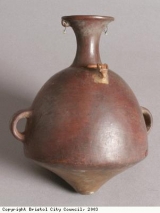The Spanish and Portuguese empires
The Spanish were the first Europeans to set foot in central and South America. Christopher Columbus was the first European to arrive in the Americas in 1492. This sailor from Genoa (now part of Italy) was funded by the Spanish king and queen. He landed in the Bahamas, a small group of islands in the Caribbean and claimed the land for Spain. Hernán Cortés, also from Spain, landed on the coast of Mexico in South America in 1519. Shortly afterwards, the Spanish defeated the Aztec people. The Aztec had settled in what is now Mexico City in AD 1345. They had built a huge, wealthy empire by warfare against neighbouring peoples. The country of Mexico was taken by the Spanish in 1521. In 1532, the Spaniard Francisco Pizarro arrived with a small force of men in Peru, a country south of Mexico. They defeated the Inca people. The Inca also had a large empire, which stretched along the coast of South America covering what is today the country of Peru and part of Chile. The Inca empire became part of the Spanish empire.
Spain conquered and ruled vast areas in central and South America. Precious metals such as gold and silver, land and a large population to provide labour were the attractions. The large population did not last, however. Before the Spanish arrived, the population of central and South America is estimated at about 50 million people. After one hundred years of Spanish rule, only about 8 million people were left. The local populations were killed by many different things. European diseases like smallpox and measles, never before encountered in the Americas, were deadly to local people. Warfare by the Spanish, using guns, and forced labour in mines and on plantations also contributed.
The local Amerindian population were enslaved by the Spanish, and forced to work. As they died, new workers were needed. Large numbers of Spanish people came to live and work in their new lands of Central and South America. However, it was not the Spanish that were going to do the hard work. The friar Bartolom‘ de Las Casas was appalled at the effect the Spanish conquest had on the Amerindian people. In 1535 he advised that Africans would be better suited to the work. Gradually, enslaved Africans were brought across the Atlantic Ocean from Africa to work in the mines and on the plantations. Later, de Las Casas came to regret this advice. He wrote against the enslavement of Africa, but this work was not published for 350 years.
The Portuguese explorer Cabral had discovered the South American country of Brazil in 1500. The Portuguese began to settle the land. For about 50 years the main interest was in the brazilwood, a tree used for dye, which gave its name to the new colony. Sugar plantations were first established in the 1540s, and over the years more and more land was cleared for growing sugar. Land and money to start plantations were given to the settlers by the Portuguese authorities to encourage them to go there. These land grants included the labour of the local Amerindian people, but this was forced, unpaid, labour. Many of the local people were enslaved. By 1570, there were about 20-30,000 enslaved Amerindians, who were valued at 1 escudo each. (The escudo was worth between 5 and 10 shillings, or 25 and 50 pence).There were also 2-3,000 enslaved Africans, valued at 13 to 40 escudos each. The higher price shows that the African slaves were obviously thought to be better workers. Their numbers rose as more were imported.
In 1630, the Dutch took Brazil from the Portuguese. Within twenty years, the Portuguese had regained Brazil from the Dutch. War between England and the Dutch in the 1660s was ended by an agreement called the Peace of Breda in 1667. By this peace agreement, the Dutch were in 1667 given their own South American colony. They were given the country of Surinam, on the north east coast of South America. The plantations here produced sugar, cacao (chocolate), wood for making dye, and tobacco. It was produced by the forced labour of 60,000 enslaved Africans, whom the Dutch brought in. Surinam had large numbers of runaway slaves or ‘maroons’. They had escaped from their plantations and lived in communities with other runaways in the mountains. They were not officially free, but were often left alone by the authorities because of the difficulties of fighting against them in the mountains and rainforest. The threat of rebellion from runaway slaves was always high. In 1761 the Dutch settlers were forced to make a peace agreement with the maroon communities.



